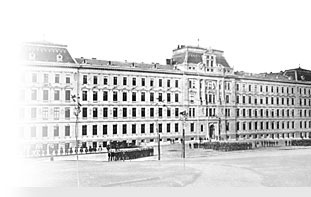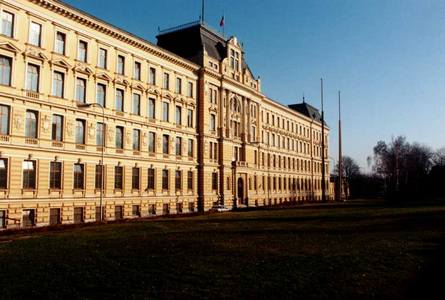
Ministerstvo obrany je ustrednim organem statni spravy pro zabezpecovani obrany Ceske republiky, ridi Armadu Ceske republiky a spravuje vojenske ujezdy.
Jako organ pro zabezpecovani obrany se podili na zpracovani navrhu vojenske obranne politiky statu, pripravuje koncepci operacni pripravy statniho uzemi, navrhuje potrebna opatreni k zajisteni obrany statu vlade Ceske republiky, Bezpecnostni rade Ceske republiky a prezidentu Ceske republiky.
Krome dalsich povinnosti souvisejicich s obranou statu povolava obcany Ceske republiky k plneni branne povinnosti.
V ramci evropskych bezpecnostnich struktur organizuje soucinnost s armadami jinych statu.
Budova Ministerstva obrany v Praze - Na Valech
Jiz nazev ulice naznacuje, ze se objekt nachazi v mistech byvale fortifikace, jejiz jadro bylo vybudovano na prelomu 17. a 18. stoleti.

Malou Stranu a Hradcany tehdy chranilo dvacet bastionu (cesky ekvivalent „bast“, presny slovnikovy vyznam „vezovite hradebni opevneni“, puvodem z italskeho „bastire“ – stavet), Nove Mesto jedenact bastionu, vysehradskou citadelu utvarelo sest bastionu s predsunutou rohovou hradbou. Silny zemni val bastionu a kurtin (hradebnich zdi mezi dvema bastiony) byl zpevnen cihlovym armovanim, u paty hradby az 3 metry silnym, rimsy byly kamenne, narozi bastionu byla vyzdena z kamennych kvadru.
Vsechny prazske bastiony byly zpravidla pojmenovany podle nejblizsich sakralnich objektu, tedy jmeny svetcu. Mimo to byla z ryze praktickych duvodu bastionum pridelena poradova cisla. Cislovani zacinalo v malostranskem useku bastionem I. (sv. Jana), ktery stal naproti Streleckemu ostrovu severne od konce dnesniho mostu Legii.
Po zruseni prazskeho pevnostniho systemu a prohlaseni Prahy za otevrene mesto (1866) bylo zapocato s postupnou likvidaci hradeb. V mistech, kde se puvodne nachazel bastion c. XV. (Vsech svatych), vyrostla na konci 19. stoleti nova kadetni skola, ve sve puvodni dislokaci zalozena r. 1869 v Kralovodvorskych kasarnach na Starem Meste Prazskem (dnes v techto mistech stoji Obecni dum a hotel Pariz).

Budova zacala svemu ucelu slouzit v roce 1900. Pocet frekventantu „kadetky“, ktera svymi naroky a pozadavky nepresahovala uroven stredni skoly, zpravidla neprekrocil pocet tri set a odpovidal potrebam vojenskeho doplnovani obvodu celych Cech. Po vzniku Ceskoslovenske republiky v roce 1918 byla skola zrusena. Pametni spis „Ceskoslovenska branna moc v prvnim roce republiky“ oznacil budovu byvale kadetky za vubec „nejvhodnejsi budovu v Praze pro umisteni ministerstva narodni obrany.“
Na zaklade zakona c. 322 Sb. z 11. cervna 1919, o zabirani budov k ucelum verejnym, byl take objekt roku 1920 vracen vojenske sprave a rada instituci, ktere zde mezitim nasly sve sidlo, jako napr. ministerstvo spravedlnosti ci Nejvyssi soud, si musela hledat nove utociste.

V roce 1921 se vsak budova na Valech stala nikoliv sidlem ministerstva narodni obrany, ale nove zalozene Vysoke skoly valecne. Po roce 1945 sem byly postupne umistovany nektere uradovny ministerstva, pracovala zde znovu obnovena Vysoka skola valecna a pozdeji az do sveho zruseni i Vojenska politicka akademie. V srpnu 1968 budovu obsadila Sovetska armada. Po dobu dalsich vice nez dvaceti let zde bylo sidlo tzv. „starsiho predstavitele hlavniho velitele Spojenych ozbrojenych sil Varsavske smlouvy u FMNO.“
Po „Sametove revoluci“ v roce 1989 budovu ziskalo opet Ministerstvo narodni obrany Ceskoslovenske republiky.

A ted k samotne kesi:
Souradnice te dovedou k velke stribrne brane ministerstva. Obcas muzes v televizi videt tiskoveho mluvciho, jak odtud komunikuje se zastupci medii. Spocitej velka svetla nad branou a dostanes dvoumistne sude cislo A. Cislo orientacni (to mensi ze dvou) je B. Dosad A a B do nasledujicich souradnic
N 50° 05.662-3*A
E 014° 31-8*B.88*A+8*B
a vydej se na druhou stage. Behem cesty si vsimni velke zelezne brany (pobliz souradnic N 50° 05.614, E 014° 24.058). Toto drive byvala hlavni vstupni brana, ktera usnadnila spojeni mezi ministrem obrany a prezidentem, jakozto vrchnim velitelem ozbrojenych sil.
Sipka te dovedla na misto, kde muzes za plotem videt schody vedouci k podzemnimu tunelu, kterym bylo mozne se nepozorovane a bezpecne dostat na Prazsky hrad (tunel bohuzel z tohoto mista videt neni). Takovych tunelu vedoucich do vsech moznych smeru je v teto oblasti vice a jiz snad neni v lidskych silach vsechny presne zmapovat. V soucasnosti je tunel z bezpecnostnich duvodu zavalen.
Pocet sloupcu na zabradli ke vchodu do tunelu je C. Dale se koukni na nejblizsi sloup verejneho osvetleni.
Soucet 2., 4. a 5. cislice je D.
N 50° 05.40*A+C*A
E 014° 23.90*D-7*A
A nyni se uz vydej k finalce, ktera neni moc daleko.
Nez se vydas k finalce, vybehni se podivat k budce u Jeleniho prikopu, ve ktere hlida hradni straz - odtud uz to je kousek .
[EN]
The Ministry of Defence is the central authority of the state administration for ensuring the defence of the Czech Republic (CR) controls the Armed Forces of the Czech Republic (ACR) and administers the military regions.
As the authority for ensuring the nation’s defence, it contributes to the formation of a strategy for the military defence policy of the country, prepares a concept for operations planning of the state territory, suggests necessary defence arrangements to the government of CR, the Defence Council of CR, and the President of CR.
In addition to other duties related to the defence of the country it calls up citizens of CR to military service in case of war or in case the country is in danger.
It organises co-ordination with the armed forces of other countries within the framework of European security structures.
Ministry of Defence Building in Prague - Na Valech Street
The name indicates that the building stands on the site of former fortifications, the core of which were erected at the end of the 17th century and the beginning of the 18th century.
At that time the Lesser Quarter and Hradcany were defended by 20 bastions, the New Town 11 and the Vyšehrad Citadel six bastions with projecting corner ramparts. The robust earthworks of the bastions and the curtain wall (walls between the bastions) were strengthened by brick reinforcements, which at the base were up to three metres thick. The corners of the bastions were dressed with stone blocks.
As a rule, all of the Prague bastions were named after the nearest sacred buildings, i.e. named after saints. The bastions were numbered for purely practical reasons. The numbering started at the Lesser Quarter section with bastion No 1. (St John), which stood opposite Shooter’s Island (Strelecký ostrov) at the northern end of what is now the Legions‘ Bridge (Most Legii).
After the Prague fortification system was abolished and Prague was declared an “open city“ (1866) the ramparts were gradually demolished. On the site of Bastion No. 15 (All Saints), a school for trainee officers was built, and at the end of the 19th century, at its original location, the Kralovodvorské Barracks were established in the Old Town (where the Municipal House (Obecní dum) and the Hotel Paríž stand today)in 1869.
The building started being used for educational purposes in 1900. It was attended by trainee offiers, and the their educational needs were such that it did not expand beyond the level of a grammar school. In general, no more than 300 trainees attended the school, and it met the needs of the military reinforcements of the whole Bohemian region. After the establishment of the Czechoslovak Republic in 1918 the school was abolished. A record of the “Czechoslovakia Armed Forces from the first year of the Republic“ singles out the former school building as “the most suitable building in Prague for the Ministry of National Defence.“
Under Act No. 322 of June 1919, on the Confiscation of Buildings for Public Purposes, the building was also returned to the military administration in 1920, and a number of institutions who had been based here, for example the Ministry of Justice and the Supreme Court, had to find new sites.
In 1921 the building on na Valech Street did not become the headquarters of the Ministry of National Defence but the newly established Military Academy. After 1945 a number of ministry offices were housed here and the re-established Military Academy was located at na Valech Street here as was, until it was abolished, the Military Political Academy. In August 1968 the building was occupied by the Soviet Army. For more than 20 years it was the headquarters of the “Senior Representative of the United Warsaw Pact Armed Forces at the Federal Ministry of National Defence.“
After the Velvet Revolution of 1989 the building was once again acquired by the Ministry of Defence of the Czechoslovak Republic.
To the treasure:
The coordinates lead you to the large silver gate of the Ministry. The Ministry of Spokesperson speaks to the media from this spot and can sometimes be seen on television. Count the lights above the gate and you will reach the number representing A. The orientation number (the smaller of the two) is B. Subsitute A a B in the following coordinates
N 50° 05.662-3*A
E 014° 31-8*B.88*A+8*B
Go to the second stage. Along the way you will notice the large iron gate (near N 50° 05.614, E 014° 24.058). which used to be the entrance gate, making it easier to link the Ministry of Defence and the office of the President, in his role as the Commander in Chief of the Armed Forces. The arrow points to a place behind the fence where you can see steps leading to an underground tunnel through which Prague Castle could be reached unobtrusively and safely. There are other tunnels in this area. and they lead in all possible directions. It not humanly possible to precisely mark them on maps. The tunnel has now been filled for safety reasons.
The number of columns on the railings to the entrance to the tunnel is C. Then look at the lamp which stands close to you. 2nd + 4th + 5th number is D.
N 50° 05.40*A+C*A
E 014° 23.90*D-7*A
Now, head towards the final point, which is close .